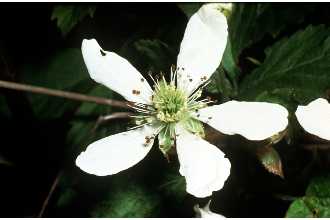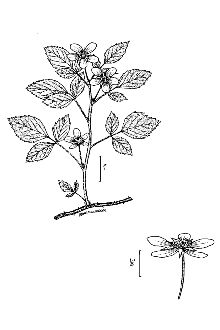Rubus frustratus L.H. Bailey
Scientific Name: Rubus frustratus L.H. Bailey
Synonyms: Rubus alacer L.H. Bailey, Rubus arundelanus Blanch., Rubus arundelanus Blanch. var. <i>jeckylanus</i> (Blanch.) L.H. Bailey, Rubus ascendens Blanch., Rubus ashei L.H. Bailey, Rubus bonus L.H. Bailey, Rubus camurus L.H. Bailey, Rubus clausenii L.H. Bailey, Rubus connixus L.H. Bailey, Rubus cordialis L.H. Bailey, Rubus dissitiflorus Fernald, Rubus enslenii Tratt., Rubus exemptus L.H. Bailey, Rubus frustratus L.H. Bailey, Rubus geophilus Blanch., Rubus jaysmithii L.H. Bailey var. <i>angustior </i>, Rubus longipes Fernald, Rubus maltei L.H. Bailey, Rubus neonefrens L.H. Bailey, Rubus occultus L.H. Bailey, Rubus procumbens Muhl., Rubus sailori L.H. Bailey, Rubus serenus L.H. Bailey, Rubus subuniflorus Rydb., Rubus tetricus L.H. Bailey, Rubus tracyi L.H. Bailey, Rubus urbanianus L.H. Bailey, Rubus villosus Aiton
Classification: Plantae/ Tracheobionta / Spermatophyta / Magnoliophyta / Magnoliopsida / Rosidae / Rosales / Rosaceae / Rubus L./ Rubus frustratus L.H. Bailey

| General Information | |
|---|---|
| Usda Symbol | RUFR10 |
| Group | Dicot |
| Life Cycle | Perennial |
| Growth Habits | Subshrub |
| Native Locations | RUFR10 |
Plant Guide
Use a soil moisture meter to monitor the soil moisture where Rubus frustratus L.H. Bailey is planted.
Plant Traits
Growth Requirements
| Temperature, Minimum (°F) | -23 |
|---|---|
| Adapted to Coarse Textured Soils | Yes |
| Adapted to Fine Textured Soils | Yes |
| Adapted to Medium Textured Soils | Yes |
| Anaerobic Tolerance | None |
| CaCO3 Tolerance | Low |
| Cold Stratification Required | Yes |
| Drought Tolerance | Low |
| Fertility Requirement | Low |
| Fire Tolerance | High |
| Frost Free Days, Minimum | 180 |
| Hedge Tolerance | High |
| Moisture Use | High |
| pH, Maximum | 7.0 |
| pH, Minimum | 5.0 |
| Planting Density per Acre, Maxim | 3450 |
| Planting Density per Acre, Minim | 2700 |
| Precipitation, Maximum | 40 |
| Precipitation, Minimum | 15 |
| Root Depth, Minimum (inches) | 6 |
| Salinity Tolerance | None |
| Shade Tolerance | Intermediate |
Morphology/Physiology
| Bloat | None |
|---|---|
| Toxicity | None |
| Resprout Ability | Yes |
| Shape and Orientation | Prostrate |
| Active Growth Period | Spring and Summer |
| C:N Ratio | Medium |
| Coppice Potential | No |
| Fall Conspicuous | No |
| Fire Resistant | No |
| Flower Color | White |
| Flower Conspicuous | Yes |
| Foliage Color | Green |
| Foliage Porosity Summer | Dense |
| Foliage Porosity Winter | Porous |
| Fruit/Seed Color | Black |
| Nitrogen Fixation | None |
| Low Growing Grass | No |
| Lifespan | Short |
| Leaf Retention | No |
| Known Allelopath | No |
| Height, Mature (feet) | 3.0 |
| Growth Rate | Rapid |
| Growth Form | Thicket Forming |
| Fruit/Seed Conspicuous | Yes |
| Foliage Texture | Coarse |
Reproduction
| Vegetative Spread Rate | Rapid |
|---|---|
| Small Grain | No |
| Seedling Vigor | High |
| Seed Spread Rate | Rapid |
| Seed per Pound | 170000 |
| Fruit/Seed Persistence | No |
| Propagated by Tubers | No |
| Propagated by Sprigs | Yes |
| Propagated by Sod | No |
| Propagated by Seed | Yes |
| Propagated by Corm | No |
| Propagated by Container | Yes |
| Propagated by Bulb | No |
| Propagated by Bare Root | Yes |
| Fruit/Seed Period End | Fall |
| Fruit/Seed Period Begin | Summer |
| Fruit/Seed Abundance | High |
| Commercial Availability | Routinely Available |
| Bloom Period | Late Spring |
| Propagated by Cuttings | Yes |
Suitability/Use
| Veneer Product | No |
|---|---|
| Pulpwood Product | No |
| Protein Potential | Low |
| Post Product | No |
| Palatable Human | Yes |
| Palatable Graze Animal | Low |
| Palatable Browse Animal | Low |
| Nursery Stock Product | Yes |
| Naval Store Product | No |
| Lumber Product | No |
| Fodder Product | No |
| Christmas Tree Product | No |
| Berry/Nut/Seed Product | Yes |


